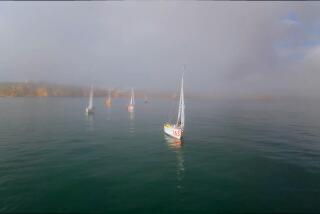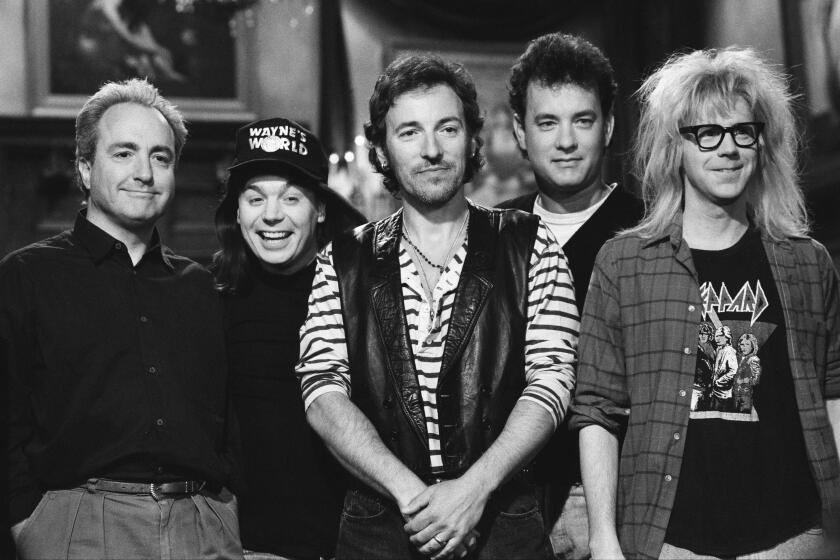THE PERFECT STORM: A True Story of Men Against the Sea.<i> By Sebastian Junger</i> .<i> W.W. Norton: 227 pp., $23.95</i>
- Share via
In October 1991, Sebastian Junger was standing on the shore of Gloucester, Mass., as winds howled, waves crested at 100 feet, ships were overturned, rescues were effected, men died. In “The Perfect Storm,” he writes: “A mature hurricane is by far the most powerful event on Earth; the combined nuclear arsenals of the United States and the former Soviet Union don’t contain enough energy to keep a hurricane going for one day. A typical hurricane encompasses a million cubic miles of atmosphere and could provide all the electric power needed by the United States for three or four years. During the Labor Day hurricane of 1935, winds surpassed 200 miles an hour and people caught outside were sandblasted to death.”
Junger investigated the lives and deaths of six fishermen who went down with their fishing boat, the 72-foot Andrea Gail, off the coast of Nova Scotia; he tracked the course of the storm, investigated other vessels caught in the storm, researched the training of rescue jumpers and interviewed meteorologists. The “perfect storm” of the title was bestowed on the Halloween Gale of 1991 by a meteorologist named Bob Case, who saw “perfection in strange things, and the meshing of three completely independent weather systems to form a hundred-year event is one of them. My God, thought Case, this is the perfect storm.”
I once sailed to Antarctica across the Drake Passage, that infamous 600-mile strait between the southern tip of South America and the Antarctic peninsula, generally considered to be the roughest, windiest body of open water for sailing in the world. It may very well be, but we were aboard a cruise ship and, although we were all seasick as we shared stories about the dangers of open-water sailing, we were in danger only of losing our lunches, not our lives. The Drake Passage is that region where so many sailing ships ran into trouble trying to round Cape Horn, and our stories imparted to our voyage a historical sense of danger, almost all of it imaginary. There is nothing imaginary about Junger’s book; it is all terrifyingly, awesomely real.
“The Perfect Storm” is actually several stories, interlarded with the history of New England fisheries; explanations of wind, wave and weather phenomena; a detailed discussion of the phenomenon of drowning; and the training work of rescue jumpers, all of which helps us to understand and follow the narrative without having to stumble over arcane definitions.
In less competent hands, this abundance of information might impede the progress of the narrative. But, for the most part, the book--like the storm it describes--rolls along toward its inevitable conclusion: the sinking of the Andrea Gail and the death of its crew. If we didn’t know the story of technological advances in fishing and the diminishing fish stocks that resulted, we wouldn’t understand why these men had risked their lives so far offshore. And if we didn’t understand the complex, sometimes lethal interactions between waves and wind, we would be denied the very heart of the story.
Billy Tyne, Bobby Shatford, David Sullivan, “Bugsy” Moran, Dale Murphy and Alfred Pierre died when the Andrea Gail went down. These men were not noble heroes but ordinary working fishermen, accustomed to living and drinking hard, who chose this dangerous line of work for the money. (On a successful voyage, a hand might earn $5,000 for a month’s work; more if the fishing was particularly productive.) But while the story is about their brief lives and violent deaths, it is also about the sea--the irrepressible, all powerful, unforgiving sea.
The scale of the subject matter overpowers us: not only the vastness of the ocean as compared with the puny works of man but also waves and winds that roar outside the range of our comprehension. Waves as high as a 10-story building! Winds that can destroy any instrument designed to measure them! What is surprising is not that the Andrea Gail went down, but that any man--or, for that matter, anything made by man--could possibly survive such a violent merging of the elements.
Junger also follows what happened to the Satori, a 32-foot sailboat, sailed by a crew of two, Karen Stimson and Sue Bylander, with Ray Leonard, the boat’s owner, also aboard. During the storm, the Satori was knocked down, righted and then, in response to its mayday signal, found by a Coast Guard air-sea rescue unit. Conditions were too dangerous for a helicopter rescue, so two life rafts were dropped, but they exploded upon hitting the water. The rescue cutter Tamaroa was also dispatched; when it finally arrived on the scene, two inflatable boats were launched. In the maelstrom, one of the inflatables was punctured by the bow of the lurching Satori. Suddenly six people needed rescuing. With waves cresting at 50 feet, the seas were too rough for these little boats. Finally, Dave Moore, a Coast Guard rescue swimmer, was dropped into the water from the hovering helicopter and assisted the terrified crew of the Satori into a rescue basket dangling from the chopper.
Moore is one of an elite crew of rescue jumpers, men who jump from helicopters to rescue people in these impossible conditions. They take a six-month trauma medicine course, a water survival course and a “dunker” training course in which they are strapped into a helicopter simulator and have to escape from it underwater, upside-down and blindfolded. During one exercise, the instructor throws his whistle into the pool and the jumpers-in-training fight for it in the water. Once a swimmer obtains the whistle, he comes out of the pool. When there are only two men left fighting for the whistle, the loser of the last battle flunks out of the course.
We can only imagine what it must have been like as the gale-force winds tossed the Andrea Gail around, blowing out its windows and plunging the rails under, until the vessel filled with water and sank to the bottom: “On a steel boat the windows implode, the hatches fail, and the boat starts to flood. The crew is prevented from escaping by the sheer force of the water pouring into the cabin--it’s like walking into the blast of a fire hose.”
Junger cannot know the specific details of the last moments of the lives of the Andrea Gail’s crew, but he has assembled a version of it from knowledge of the ship’s construction and from accounts of other seamen who survived the storm. A Canadian woman who signed aboard a Japanese fishing vessel as an observer recorded her experiences as that ship almost went down in the storm. In 1892, a Scottish doctor named James Lowson was aboard a steamship bound for Ceylon when it encountered a typhoon that sank the ship. Lowson, who washed ashore on an island, described his near-drowning in the Edinburgh Medical Journal. From this and other medical references, Junger explains in frightening clinical detail how people drown.
“The Perfect Storm” is a wild ride that brilliantly captures the awesome power of the raging sea and the often futile attempts of humans to withstand it.
More to Read
Sign up for our Book Club newsletter
Get the latest news, events and more from the Los Angeles Times Book Club, and help us get L.A. reading and talking.
You may occasionally receive promotional content from the Los Angeles Times.










